Sailor 1911 Standard Promenade - Shining Blue Review

This is my first Sailor pen, the Sailor 1911 Standard Promenade, in Shining Blue. Sailor is a brand that is associated with some high-level quality, and perhaps to some, diehard fans. The brand is a love it – or hate it, with most people falling into the “love it” side, I believe. Furthermore, Sailor does do a lot of work outside their own brand, making exclusive inks for Japanese stationery stores such as Bung Box, or even pens for Western companies such as Classic Pens Inc. LB5 model. If you check out those links, you will realize how expensive those products are, $40 for a bottle of ink, and a $1,500 MSRP pen. Wow. However, it’s not like Sailor only works in the high end, with their pens like the High Ace Neo and ProColor 500 against the Pilot Prera but they aren’t really known for their low end products. It’s all about the gold, baby. I believe Sailor is the only company that uses 21K gold nibs on their pens (the full-size line and above).
Sailor was founded in 1911, by Kyugoro Sakata, when he was introduced to a fountain pen by a British sailor visiting Japan. Thus, the Sailor Pen Company was founded, 1911, and is the name of their main product, the 1911 fountain pen. [1] Sailor is part of what would be considered the “Big 3” Japanese companies producing fountain pens, and would be considered the oldest of the three. More recently, the reason Sailor is so well regarded is because of their nibs because of their nib master Nobuyoshi Nagahara and his son Yukio Nagahara, who created Sailor’s specialty nibs found on their high-ends pens[2], the 1911 Large and above, at cheapest $350 from nibs.com. A full list of their specialty nibs can be found on this page of nibs.com. While Pilot has a large variety of nibs in their upper-line of #10 size nibs, from extra-fine to broad, double broad, course, stub, falcon, music, waverly and posting), the Sailor nibs in the competing price range “only” come in fine, medium, medium-fine, broad, Naginata-Togi, and Zoom. But adding the specialty nibs, Sailor has the largest, most interesting nibs, that do not flex but rather emulate the feeling of writing with a brush or have a variety of line widths depending on the way you write with the pen. And that makes it special.
Now, depending on where you look, you will see a lot of different names for the Sailor pens. In this case, the 1911, 1911S, 1911 Standard, 1911M, 1911 Mid-size, Profit Standard are all the same pen, where the 1911 Profit (Standard) is the Japanese name and the 1911S or Mid-sized is used more in the North American market. Similarly, the Sapporo in the US, is the Pro(fessional) Gear, or the Sigma in Japan. It seems like they rebranded them at some point but I don’t know why.
However, one of the main reasons why Sailor 1911S is so disproportionally seen compared to the Pilot counterparts (Custom 74, Custom Heritage 91) would be the lack of availability outside of Japan, since Goulet Pens was dropped as an official retailer in 2013, which I would like to consider as a fairly prominent online retailer in the United States (especially with their awesome videos, and website that isn’t outdated). However, you can still buy Sailor pens from Anderson Pens or Classic Fountain Pens nibs.com. From the comments on the Goulet blog, you can definitely see some brand loyalty to Goulet but I digress. Brian Goulet also often says the Custom 74 is one of his favourites and that probably influences a large number of people to buy that over the Platinum #3776 or the Sailor 1911S.
The second reason that people end up loving or hating the Sailor brand is due to the feedback on their nibs. While I only currently own one Sailor pen, it is one of the most interesting, pleasant feeling nib I own. Some people want the wettest, glassy smooth nib as if they are flying across the paper, and I understand that. I like that feeling too, but the Sailor is just one-of-a-kind. This perfection of nib feel is very consistent in most people’s eyes, as one of the most consistently perfectly adjusted nibs around. And I drink that Kool-Aid. Heck, now I’m in love with Sailor inks too! Now let’s get onto the review.
Unboxing
So, full disclosure, I bought this pen through Penroom on Rakuten, so this might be grey-market goods. But at $74 USD without the converter, it’s a steal. Also this finish does not exist outside of Japan, in fact I could not find basically any information outside of these 3rd party sellers about this finish, so I don’t feel bad at all (sorry Goulet!). If I can buy a pen at half price, even if it’s bad I could realistically buy a second one before it becomes more value at a US distributor… Just looking out for myself now. Of course if I ever move up to the really nice pens then I probably would consider paying the premium for the support in case something did happen but again $100 is not a huge loss here.

Anyways the box comes in a cardboard sleeve with a cutout that shows the Sailor name on the box. Sliding out the box, you are presented with a dark blue leatherette case with “SAILOR” and the anchor logo in gold.

Opening up the box, the pen lays inside; get used to this packaging, it’s basically standard for the next few reviews. The gold “SAILOR” is on the top cover again.
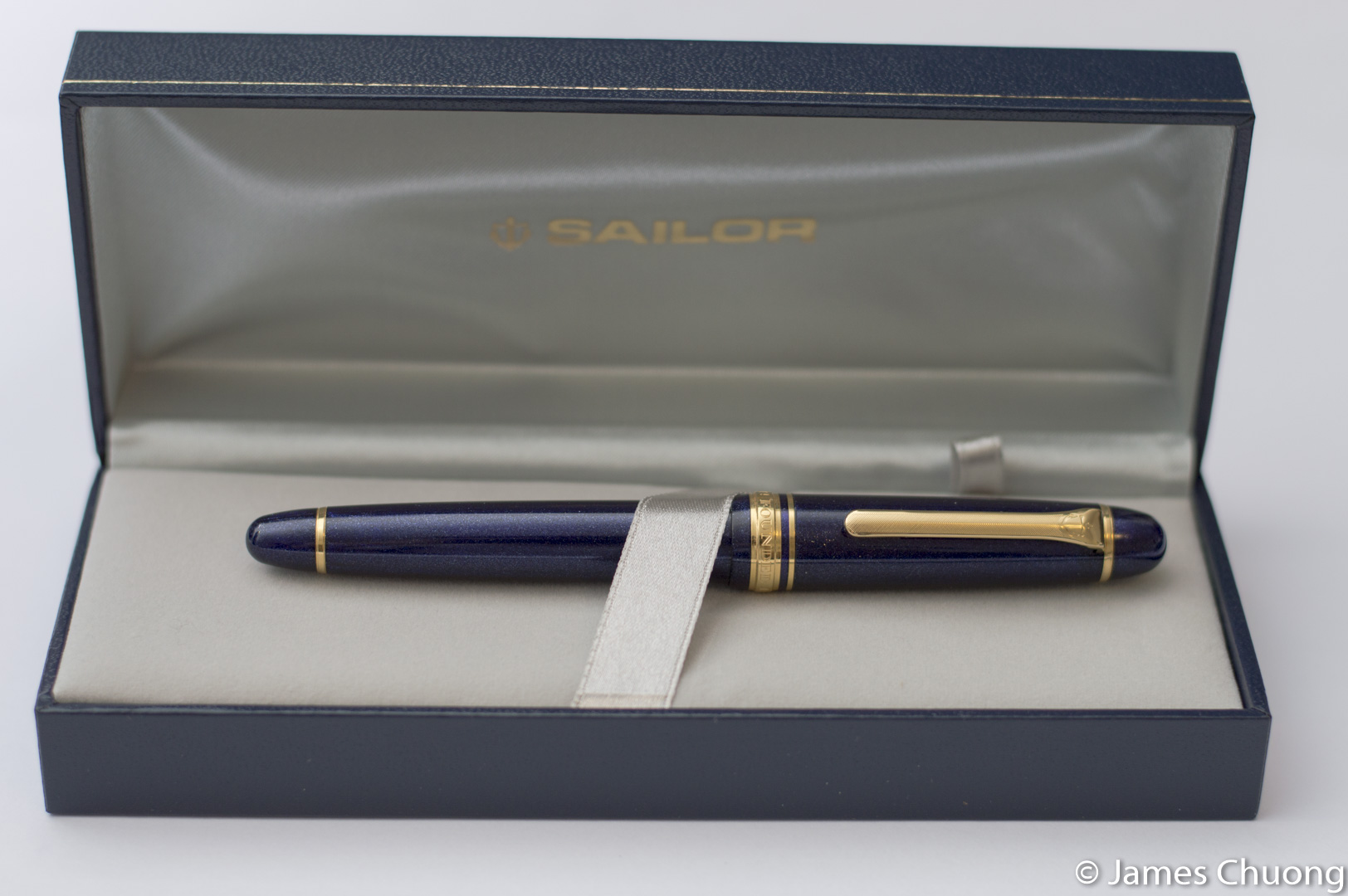
Included are two Sailor black cartridges (which I presume is the Jentle Black, not Kiwa-Guro “Nano-Black”), warranty card, and the instruction manual. Side note that the warranty was actually stamped, so either Penroom is an actual dealer or someone went to one and bought it “undercover”. Interesting. Considering they were able to get this pen immediately I want to say it is official goods (because this finish isn’t exactly easy to come by, so they owned the goods and stamped it themselves) but I have no real proof.

Features
The Sailor 1911 line-up features are classic cigar shape pens with a twist-off cap. Furthermore, with the exception of the Realo line, Sailor pens are all cartridge/converter pens that take proprietary Sailor cartridge/converters. Many of the Sailor pens feature gold furnishing, but there are some with rhodium, and a few special platings such as the Black Luster 1911 or the Imperial Black Pro Gear. On the Promenade, the furnishing is gold colored. What makes the Promenade line special is the sparkly resin used on the red and blue models, and the clip is completely different to the standard 1911. More on that in the Looks section.
The twist cap takes 2 and 1/4 turns to take off, and pushes to post. The threads of the pen are smooth when uncapping and are not sharp if you were to hold the pen on the threads. When posted, it is fairly secure but doesn’t post too deeply and that makes it a comparable size the the other Japanese offerings (pictures in a later review, I think).
Now, the 1911S is a fairly small pen uncapped – even shorter than my Esterbrook J! Compared to the Pilot Custom Heritage 92, or the Platinum #3776 Century, it is the smallest of the bunch.
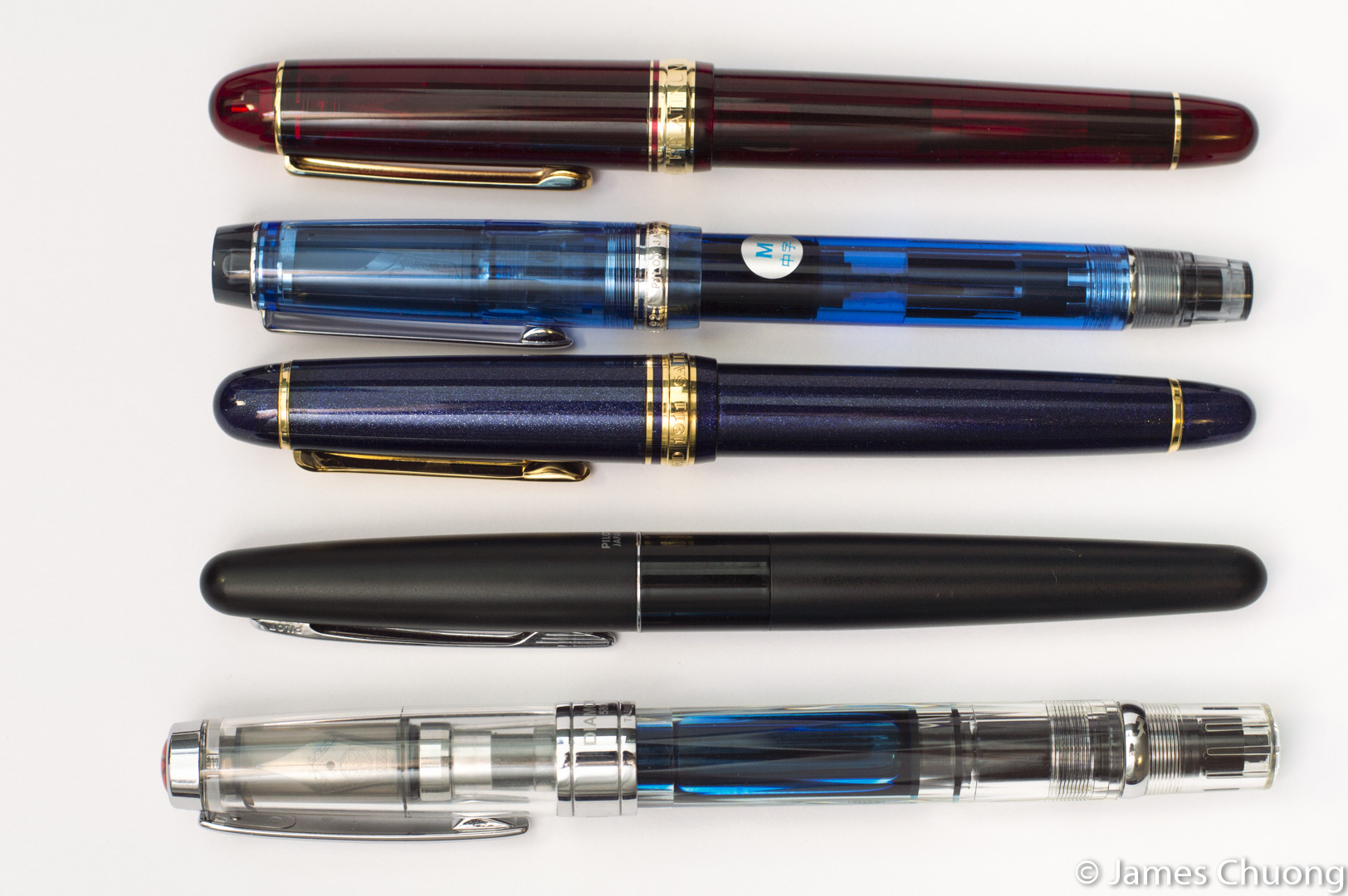
Looks
The pen I purchased is the Shining Blue version, one that isn’t available in the US at all. It is reminiscent of the Pilot Stargazer (Stella90s) finish, though the Promenade version is made of only resin. The resin is the same throughout, unlike the Stargazer which has a separate grip section, the Sailor has the same material throughout. The resin is quite something, as it is a deep blue base color, with many smaller blue / purple sparkles, and larger white sparkles which all catch the light beautifully. In my Jinhao X750 Shimmering Sands review, I thought those sparkles looked pretty lame. Well, I was spoiled by having this beautiful pen, with more tasteful sparkles that have some depth to them. By the threads, where the body meets the section, there is a gold band that keeps the classy look.

One of the major differences with the Promenade compared to the standard 1911 models is the clip. The clip is one solid material, with the Sailor anchor logo on the top with a dotted pattern down the clip. It’s sleek, and stylish, and I kind of wished other Sailor pens would have this clip, though I haven’t actually owned another Sailor pen (yet).
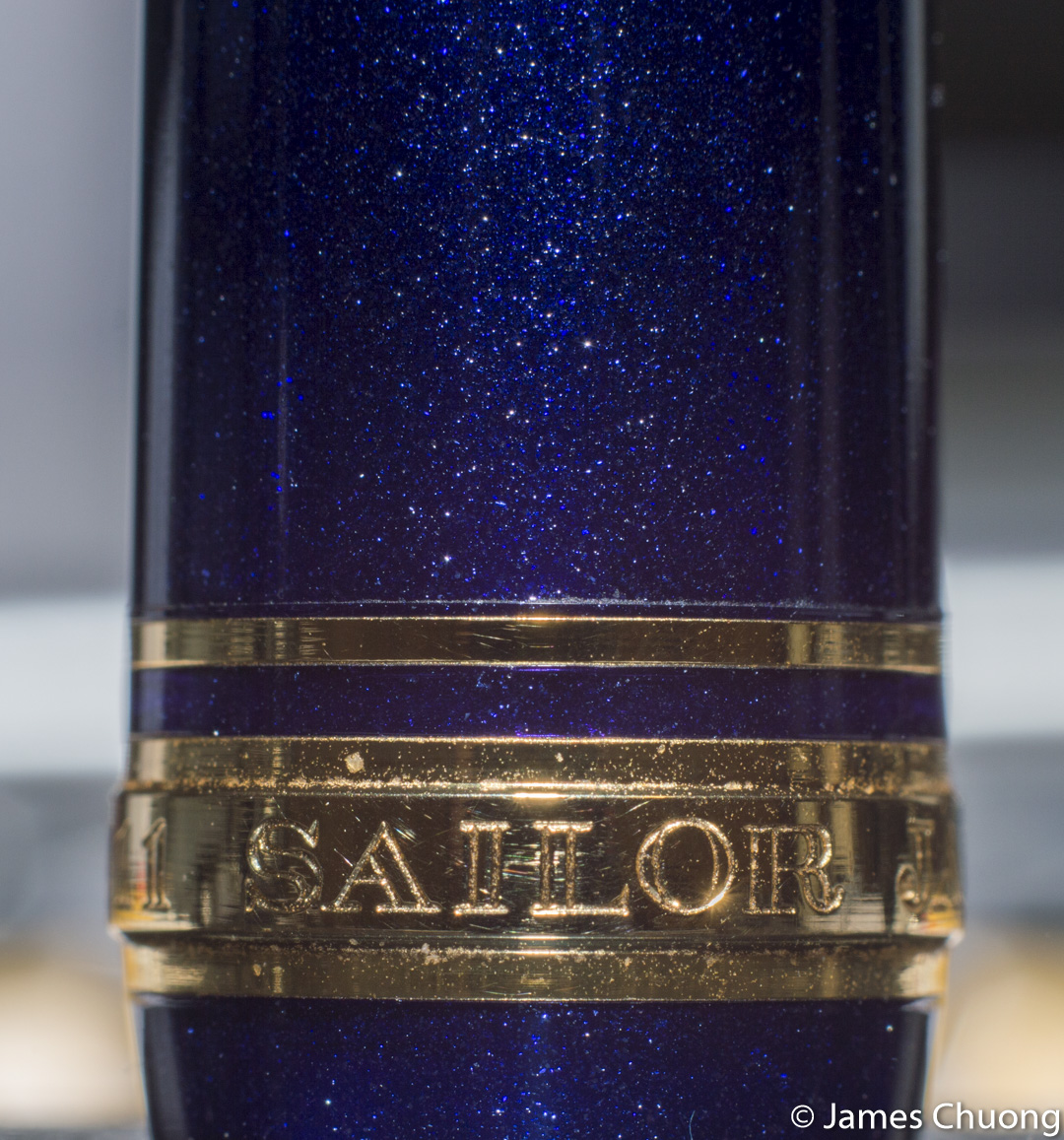
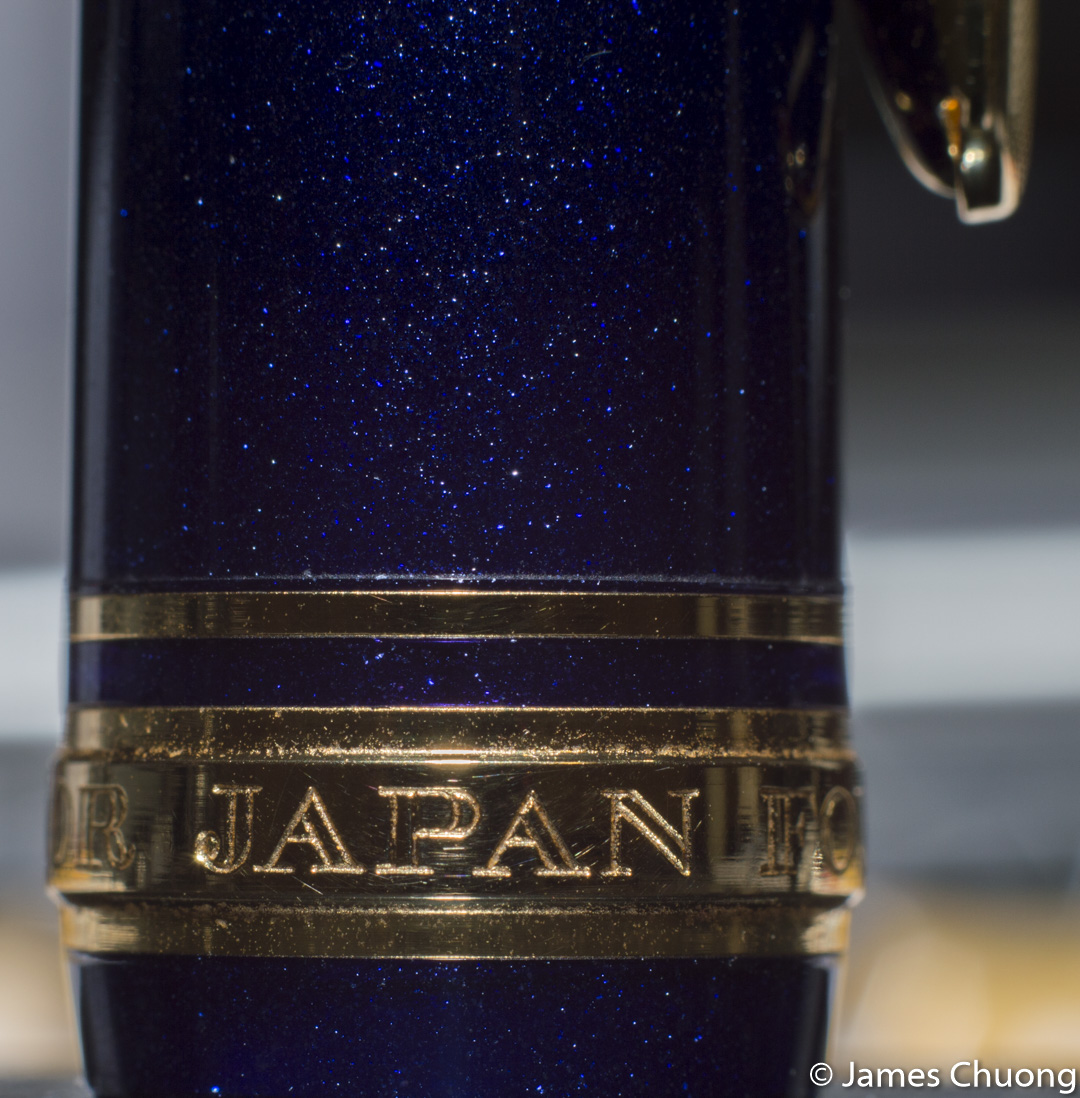
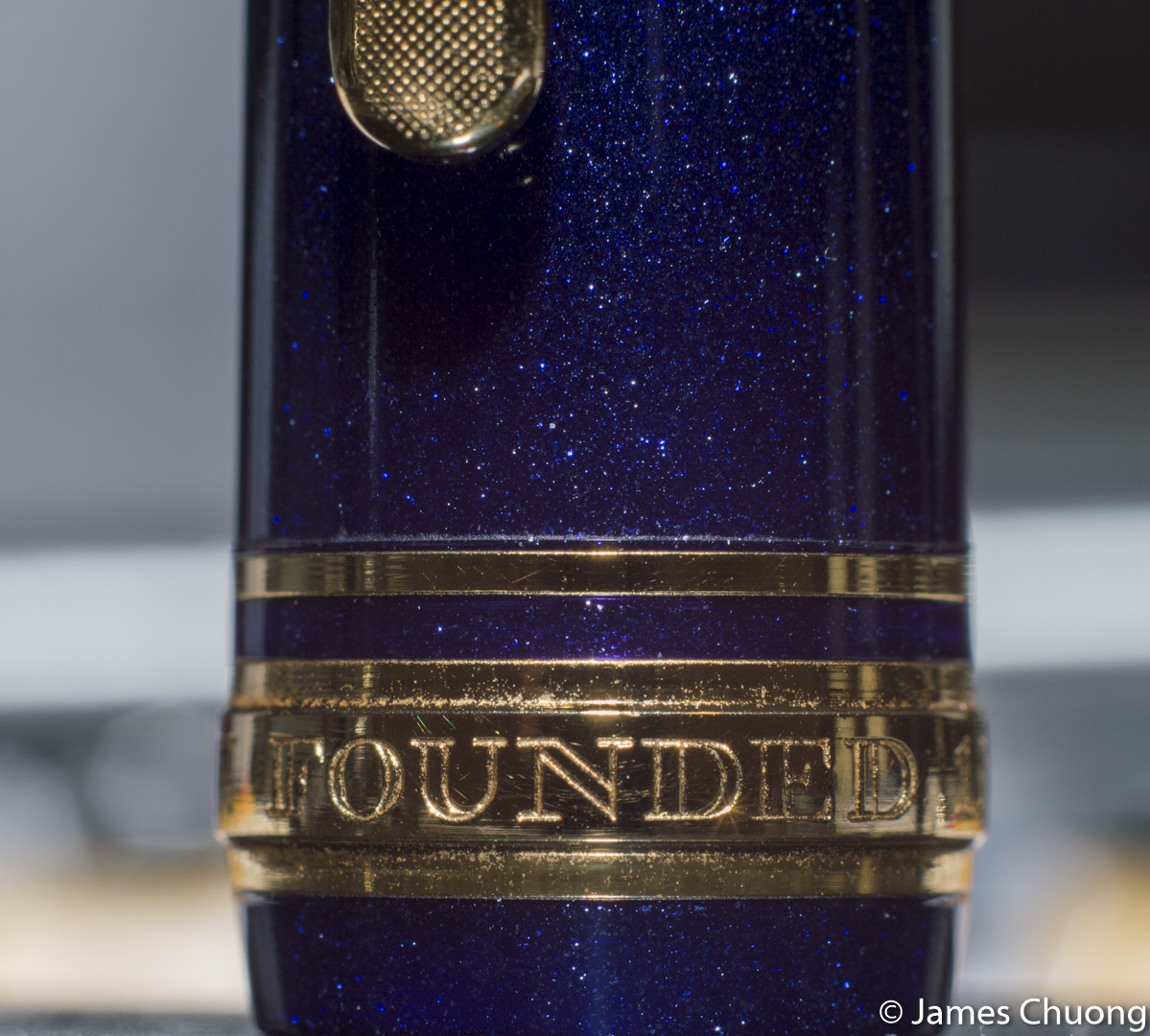
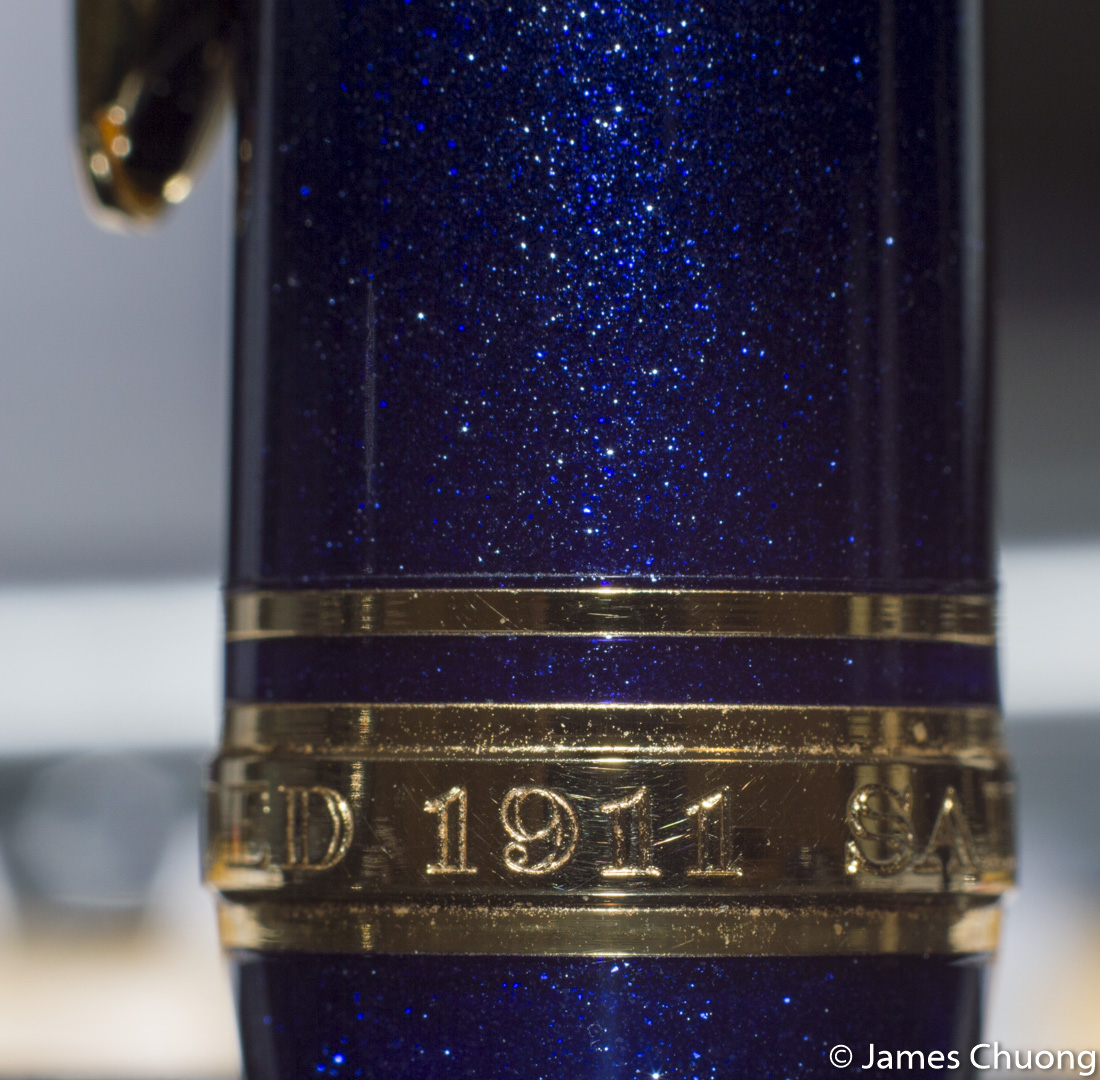
On the cap band, there is one extra gold band above it. The font that Sailor uses on their cap band is my favourite I have seen on any pen so far. On the cap band, it says “Sailor Japan Founded 1911”.

Along with my favorite cap band, the Sailor nibs are my favourite design of all my pens. The nib has a nice flourish around the nib, that connects to the nib slit. With the flourishes connected, the nib creep becomes something special, as the ink fills in the flourishes around the nib. On the nib, “1911”, the Sailor anchor, 14K, 585, Sailor is stamped onto the nib. For those who are wondering, 585 is the percent of gold (58.5%) in 14K. Finally, there is a “H-M” on the side of the nib, which stands for “hard-medium”.
Writing Experience
The writing experience is one-of-a-kind. One apt description I have read was “smooth like writing on velvet”. It’s definitely not glassy smooth, but smooth with feedback. The pen isn’t particularly wet but enough to get sheen out of it (with Sailor inks, which may be easier to sheen than other inks).
The pen is a “hard-medium” and it definitely does not have a lot of give if you try to push it. You can get some slight variation but it is not more than normal steel nibs could flex, and less than some other Japanese gold nibs. I also found that the line width was a little thinner than my Pilot Custom Heritage 92 14k gold medium.
The ink used was Sailor Jentle Four-Season Souten.

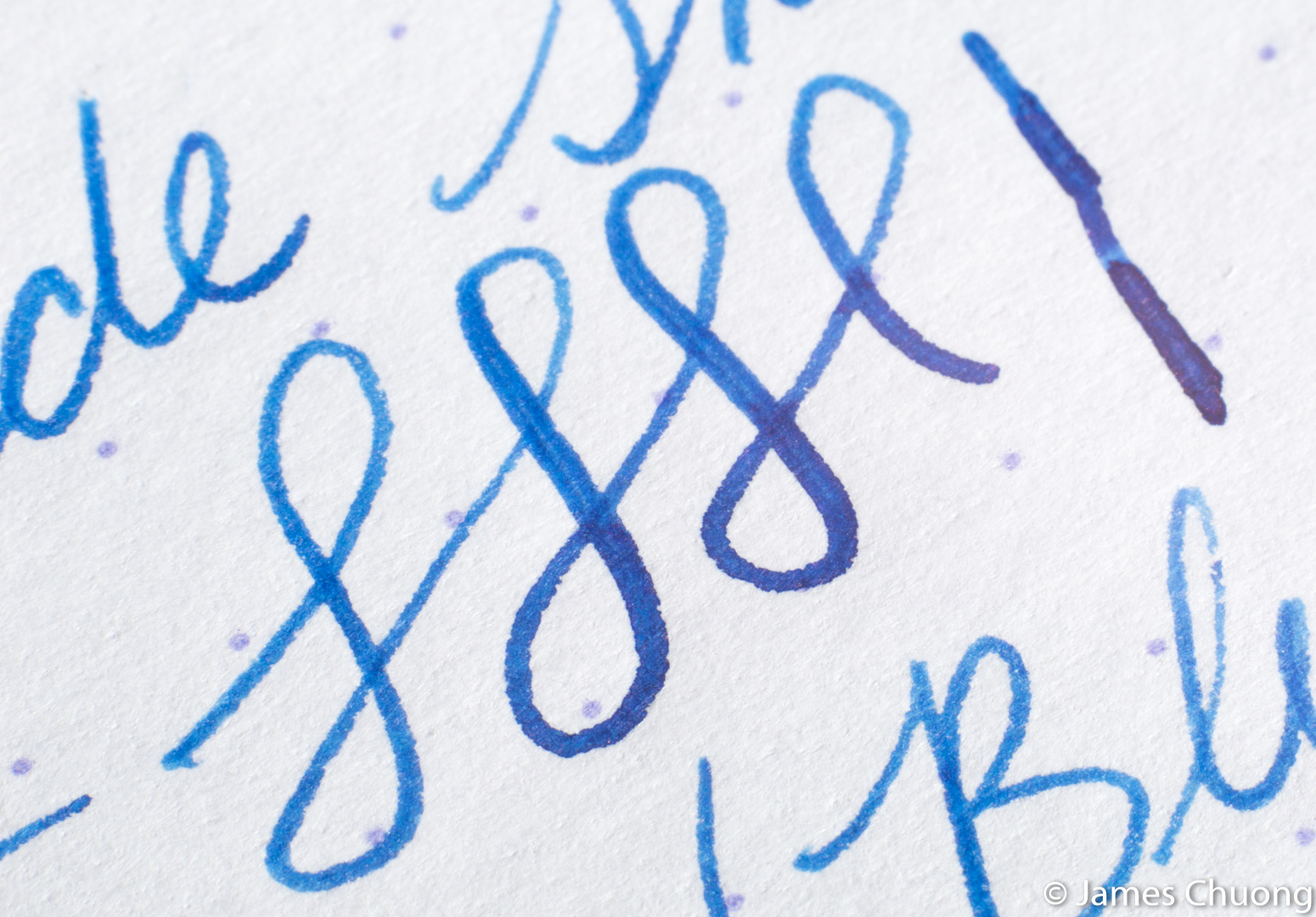
Misc and Final Thoughts
The 1911S is definitely a small and light pen, although I don’t mind writing with it unposted still. However, when compared to a nice, long and weightier pen, the Pilot Custom 823, I found that would like a little more length on the pen. Maybe the extra length of a 1911L would be better for me. The Platinum 3776 Century is a nicely sized fountain pen in comparison.
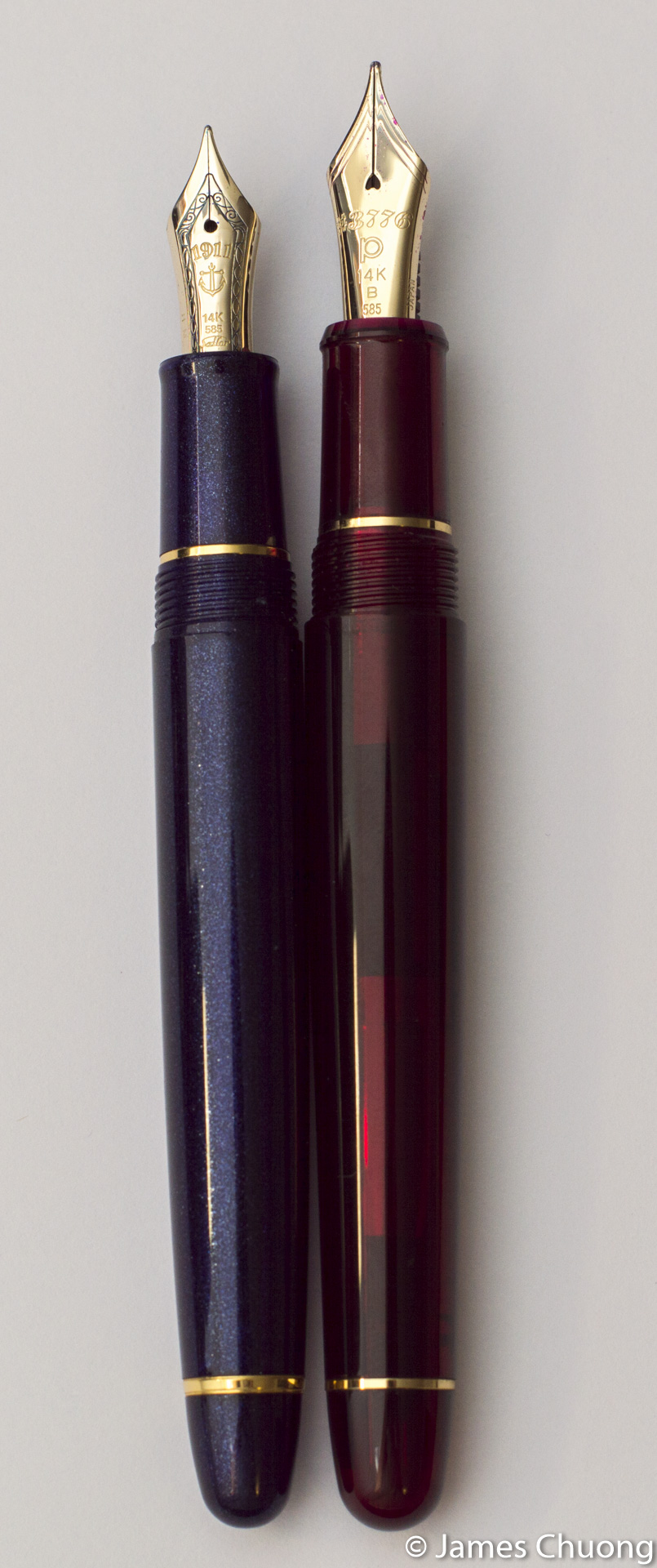
One minor issue for me is the converter that Sailor uses. Most of their pens are gold trim, and the only converter they use is a silver/chrome/steel coloured trim. In an opaque pen this is fine but their Sailor 1911S demonstrator uses gold trim and you can see the silver converter. Weird. Also it’s a small converter, at 0.5mL capacity, though in line with other Japanese converters, the Pilot CON-50 and the Platinum/Nakaya converter.

Another issue is the section has somewhat noticeable seams from (what I think) is the injection molding process. While I think many pens (in production, rather than custom) have this problem, I find it is a little more noticeable, and a little bit disappointing for a pen that would retail at this cost ($150 USD in NA).
All-in-all, this is a very well built pen, I love the looks of it, in every way. The feel of the nib is unique and lovely. Cartridge/converter might be a deal-breaker for some, but not for me. This is one of my favourite pens.
Disclaimer: I purchased this pen with my own money and was not compensated for this review. There are no referral links in this review.